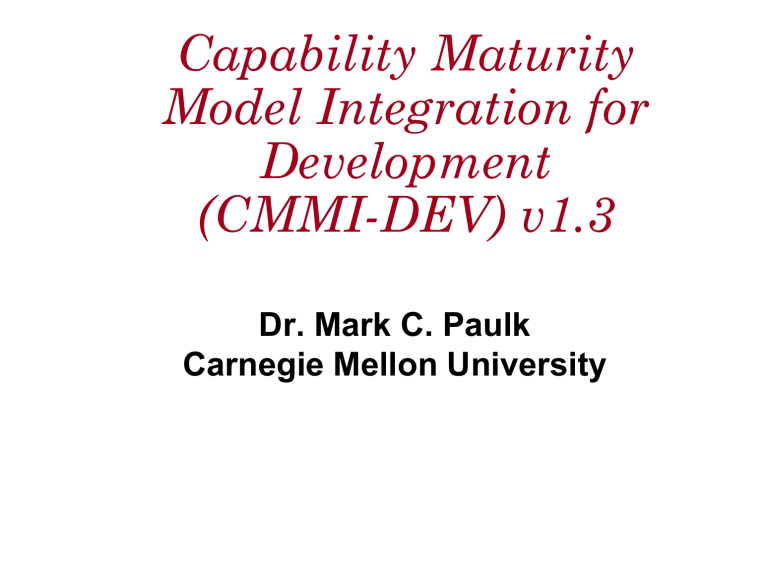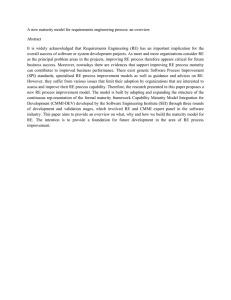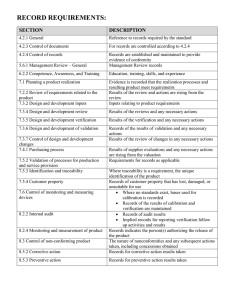Capability Maturity Model Integration for Development (CMMI-DEV) v1.3

Capability Maturity
Model Integration for
Development
(CMMI-DEV) v1.3
Dr. Mark C. Paulk
Carnegie Mellon University
The State of the Practice?
"I'd rather have it wrong than have it late. We can always fix it later."
A senior software manager (industry)
"The bottom line is schedule. My promotions and raises are based on meeting schedule first and foremost."
A program manager (government)
Standish Group – the Chaos Report
• 24% of software projects failures (2009)
from 31% failures (1994)
• 44% of software projects challenged (2009)
from 53% challenged (1994)
“By regularly putting the development process under extreme time pressure and then accepting poor-quality products, the software user community has shown its true quality standard.”
DeMarco and Lister (Peopleware)
Process Management Premise
The quality of a (software) system is largely governed by the quality of the process used to develop and maintain it.
This premise implies focus on process as well as product.
The value of this premise is visible world-wide in the Total Quality Management movements in the manufacturing and service industries.
performance excellence against business objectives
doing more with less
increasing customer satisfaction (and delight)
improving shareholder equity
Implications of Maturity
Better predictability… Less variability… Improved performance…
Level Process Characteristics
5 Optimizing Process improvement is institutionalized
Predicted Performance
Time/$/...
4 Managed Product and process are quantitatively controlled
3
Defined
2 Repeatable
1
Initial
Software engineering and management processes defined and integrated
Project management system in place; performance is repeatable
Process is informal and unpredictable
Time/$/...
Time/$/...
Time/$/...
Time/$/...
Trends in Software Quality
Maturity
Level
Design
Faults /
KSLOC
(Keene)
Delivered
Defects /
FP
(Jones)
Shipped
Defects /
KSLOC
(Krasner
Relative
Defect
Density
(Williams)
Shipped
Defects
(Rifkin)
5
4
3
2
1
0.5
1
2
3
5-6
0.05
0.14
0.27
0.44
0.75
0.5
2.5
3.5
6
30
0.05
0.1
0.2
0.4
1.0
1
5
7
12
61
Samuel Keene, “Modeling Software R&M Characteristics.” Unpublished report.
Capers Jones, “Software Benchmarking,” IEEE Computer, October 1995.
Herb Krasner, “Self-Assessment Experience at Lockheed,” Third Annual SEPG Workshop, November 1990.
Karl D. Williams, "The Value of Software Improvement… Results! Results! Results!" SPIRE97, June 1997.
Stan Rifkin, “The Business Case for Software Process Improvement,” Fifth SEPG National Meeting, April 1993.
Trends in Productivity
Maturity
Level
2
3
4
5
Business
Systems PI
17
19.5
22
25
Engineering
Systems PI
15
18
20.5
23
Real-Time
Systems PI
9
11.5
14
16.5
Lawrence H. Putnam, “Linking the QSM Productivity Index with the
SEI Maturity Level,” QSM, 2000.
Level
5
Optimizing
CMMI-DEV v1.3
Process
Characteristics
Process Areas
Focus is on quantitative continuous process improvement
Causal Analysis & Resolution
Organizational Performance Management
4
Quantitatively
Managed
Process is measured and controlled
3
Defined
2
Managed
1
Initial
Organizational Process Performance
Quantitative Project Management
Process is characterized for the organization and is proactive
Process is characterized for projects and is often reactive
Requirements Development Organizational Process Focus
Technical Solution
Product Verification
Verification
Validation
Organizational Process Definition
Organizational Training
Integrated Project Management
Risk Management
Decision Analysis & Resolution
Requirements Management
Project Planning
Project Monitoring & Control
Supplier Agreement Management
Configuration Management
Measurement & Analysis
Product & Process Quality Assurance
Process is unpredictable, poorly controlled, and reactive
7
Comparing Capability and
Maturity Levels
Level
Continuous
Representation
Capability
Levels
0 Incomplete
1 Performed
2 Managed
3 Defined
4 ---
5 ---
Staged
Representation
Maturity
Levels
---
Initial
Managed
Defined
Quantitatively
Managed
Optimizing
8
A Performed Process and the
Level 1 Generic Practice
A performed process is a process that accomplishes the work necessary to satisfy the specific goals of a process area.
GG 1 Achieve Specific Goals
GP 1.1 Perform Specific Practices
9
A Managed Process
A managed process is a performed process that is
• planned and executed in accordance with policy;
• employs skilled people having adequate resources to produce controlled outputs;
• involves relevant stakeholders;
• is monitored, controlled, and reviewed; and
• is evaluated for adherence to its process description.
10
Level 2 Generic Practices
GG 2 Institutionalize a Managed Process
GP 2.1 Establish an Organizational Policy
GP 2.2 Plan the Process
GP 2.3 Provide Resources
GP 2.4 Assign Responsibility
GP 2.5 Train People
GP 2.6 Control Work Products
GP 2.7 Identify and Involve Relevant Stakeholders
GP 2.8 Monitor and Control the Process
GP 2.9 Objectively Evaluate Adherence
GP 2.10 Review Status with Higher Level Management
11
CMMI-DEV v1.3 ML2
Requirements Management
Project Planning
Project Monitoring & Control
Supplier Agreement Management
Process & Product Quality Assurance
Configuration Management
Measurement & Analysis
REQM
PP
PMC
SAM
PPQA
CM
MA
12
CMMI-DEV v1.3 Project Management – Level 2 PP
Project Planning
Establish and maintain plans that define project activities.
Specific Goals
1) Establish estimates.
2) Develop a project plan.
3) Obtain commitment to the plan.
13
CMMI-DEV v1.3 Support – Level 2 PPQA
Process & Product
Quality Assurance
Provide staff and management with objective insight into processes and associated work products.
Specific Goals
1) Objectively evaluate processes and work products.
2) Provide objective insight.
Note that product quality assurance, as described in PPQA, is against applicable process descriptions, standards, and procedures. It is not against requirements. Practices in the
Verification process area ensure that specified requirements are satisfied.
14
A Defined Process and the
Level 3 Generic Practices
A defined process is a managed process that is
• tailored from the organization ’s set of standard processes according to the organization ’s tailoring guidelines;
• has a maintained process description; and
• contributes process related experiences to the organizational process assets.
GG 3 Institutionalize a Defined Process
GP 3.1 Establish a Defined Process
GP 3.2 Collect Process Related Experiences
15
CMMI-DEV v1.3 ML3
Requirements Development
Technical Solution
Product Integration
Verification
Validation
Organizational Process Definition
Organizational Process Focus
Organizational Training
Integrated Project Management
Risk Management
Decision Analysis & Resolution
RD
TS
PI
VER
VAL
OPD
OPF
OT
IPM
RSKM
DAR
16
CMMI-DEV v1.3 Engineering – Level 3 VER
Verification
Ensure that selected work products meet their specified requirements.
Specific Goals
1) Prepare for verification.
2) Perform peer reviews.
3) Verify selected work products.
Note that IEEE 610-1990 defined verification as “The process of evaluating a system or component to determine whether the products of a given development phase satisfy the conditions imposed at the start of that phase.
”
17
CMMI-DEV v1.3 Engineering – Level 3 VAL
Validation
Demonstrate that a product or product component fulfills its intended use when placed in its intended environment.
Specific Goals
1) Prepare for validation.
2) Validate product or product components.
Note that validation is against “intended use.. in its intended environment ” rather than against the requirements. IEEE 610-1990 defined validation as “The process of evaluating a system or component during or at the end of the development process to determine whether it satisfies specified requirements.
”
18
Verification and Validation
IEEE 610-1990 defined V&V as “The process of determining whether the requirements for a system or component are complete and correct, the products of each development phase fulfill the requirements or conditions imposed by the previous phase, and the final system or component complies with specified requirements.
”
This seems to fit the CMMI definitions of V&V better than the individual definitions do. Caveat emptor!
19
CMMI-DEV v1.3 ML4
Quantitatively Managed
Organizational Process Performance
Quantitative Project Management
OPP
QPM
20
CMMI-DEV v1.3 ML5
Optimizing
Causal Analysis & Resolution CAR
Organizational Performance Management OPM
21
CMMI-DEV v1.3 Support – Level 5 CAR
Causal Analysis & Resolution
Identify causes of selected outcomes and take action to improve process performance.
Specific Goals
1) Determine causes of selected outcomes.
2) Address causes of selected outcomes.
“Defects” in CMMI v1.2 became “selected outcomes ” in CMMI v1.3.
22
IPPD
Integrated Process & Product Development disappeared between CMMI-DEV v1.2 and v1.3.
• Replaced by teaming practices OPD SP 1.7 and IPM SP 1.6
“IPPD” and “integrated process and product development ” do not appear in v1.3.
Teaming and IPPD are arguably not synonyms.
23
CMMI Complexity
From Joe Zec ’ s review of Practical Insight into CMMI: The Look and Feel of a Successful Implementation by Tim Kasse (2004), published in ASQ
Software Quality Professional, June 2005, page 42.
“ One thing the book unintentionally reveals is the enormous complexity of the CMMI. The number of process areas, goals, and practices is truly staggering. One can ’ t help but wonder if the CMMI is in danger of collapsing under its own weight. But this is all the more reason to add a book like this to one ’ s reference shelf.
”
24
Questions and Answers
Contact Information
Dr. Mark C. Paulk
Institute for Software Research
Carnegie Mellon University
Wean Hall 5101
5000 Forbes Avenue
Pittsburgh, PA 15213 USA
Email: mcp@cs.cmu.edu
or Mark.Paulk@ieee.org
Web: http://www.cs.cmu.edu/~mcp/

